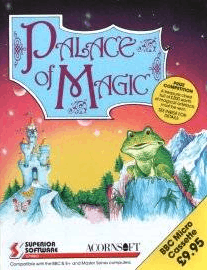Palace of Magic
|
Cover art | |
| Developer(s) | Martyn R Howard |
|---|---|
| Publisher(s) | Superior Software |
| Designer(s) | Stephen Wileman, Stephen Chester, Robert Asser |
| Platform(s) |
Acorn Electron BBC Micro |
| Release date(s) |
|
| Genre(s) | Platform |
| Mode(s) | Single-player |
Palace of Magic is a computer game released on 1 November 1987 for the Acorn Electron and BBC Micro by Superior Software. Combining platform elements with problem solving, it uses extremely similar gameplay principles to that of the earlier and better known game, Citadel. As with that game, it is an early example of the Metroidvania genre.[2][3]

The game begins with your character in a palace, having been shrunk and taken out of your normal place and time by an evil wizard called Caldeti (an anagram of Citadel). The overall objective is to magically restore your character to his original size and to find the teleporter to their home world. This involves guiding your character through the Palace and other external locations, such as a church, woods and a dungeon, overcoming various obstacles and enemies along the way.
Similarities to Citadel
The player is not automatically killed if they come into contact with hazards; instead the player is allocated a set amount of energy (but this time measured by a bar, subdivided into units), which is depleted through contact, and can be replenished by collecting objects shaped like top hats. As in Citadel, the game is divided into 'rooms' or screens and if the player loses too much energy in a room, the screen turns red and the player is transported back to where they entered the room. This prevents players from passing through a room simply by walking through enemies and taking the damage.
Other similarities to Citadel include:
- Some areas of the game are not immediately accessible, but are blocked by coloured doors. In order to gain access the player needs to find a key with the same colour.
- Various objects are scattered throughout the game which must be collected to overcome obstacles and hazards.
- The location of a particular screen is provided by (x,y) co-ordinates, with (0,0) being the starting screen of the game.
- The player sprite is not superimposed over objects that it walks "in front" of; rather, the colour of the pixels of the character sprite is overlaid, using an XOR bitwise operation, with the colour of the superimposed object, resulting in a completely different colour.
Differences Between BBC And Electron Versions
Whilst the layout of the Palace and the mechanics of the game are identical between the two machines, the BBC version runs in a higher resolution (seven colour Mode 2) whilst the Electron version runs in four colour Mode 5. The BBC version also includes a vertical hardware scroll when the player strikes the ground after a long fall, and flickering pixels above the collectible top hats.
Palace Of Magic 2016 Remake
In 2016, a new Acorn Electron version of Palace Of Magic was released.[4] Called Palace Of Magic 2016, this new version is seemingly identical to the higher resolution Mode 2 BBC Micro version, with some clever coding employed to allow it to run on the (less technically advanced) Electron.
References
- ↑ Palace of Magic at GameFAQs
- ↑ Szczepaniak, John. "Backtracking: The History of Metroidvania". GamesTM (116). Imagine Publishing. pp. 148–53.
- ↑ Dransfield, Ian (February 27, 2015). "The Swindle preview: The death and rebirth of Size Five's crime caper". Digital Spy. Retrieved July 10, 2016.
[T]his harks back to the times of BBC Micro games like Castle Quest or Palace of Magic: really brutal, unfair Metroid-style things.
- ↑ Everygamegoing
